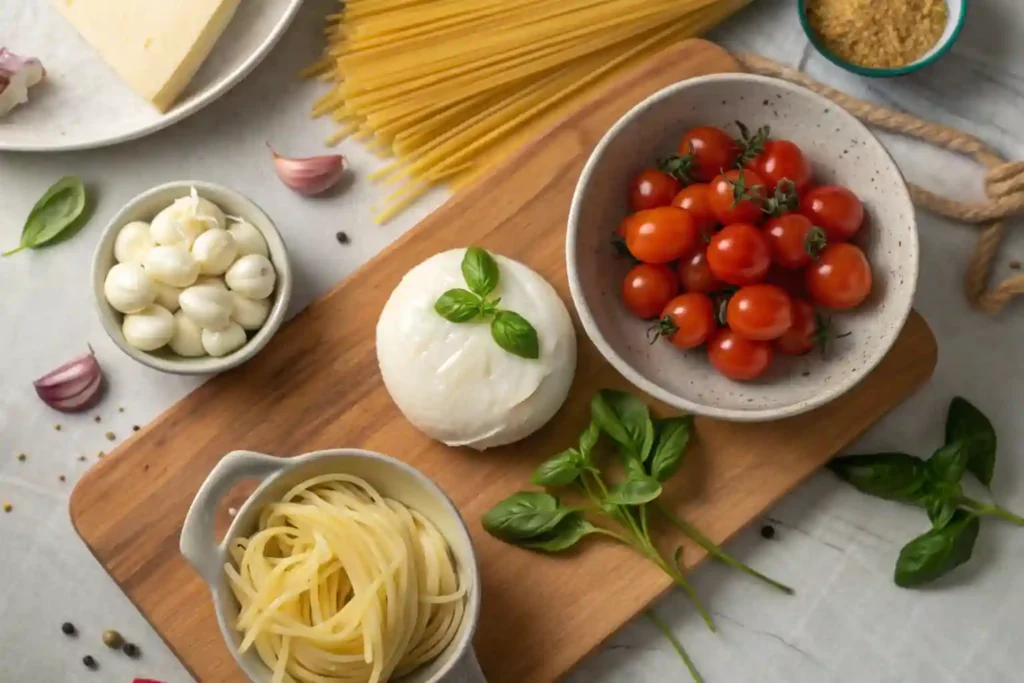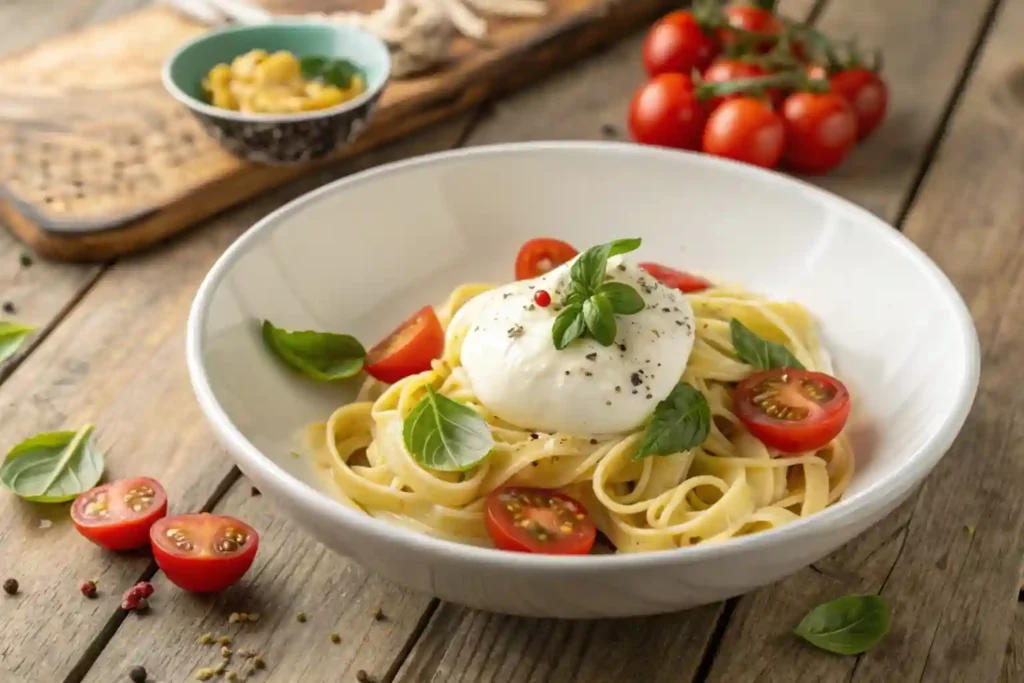Table of Contents
1. Introduction to Burrata Pasta
Burrata pasta at home is a delightful dish that combines the creamy richness of burrata cheese with the comforting texture of pasta. Originating from Italy, this dish has gained popularity worldwide for its simplicity and flavor.
- What is Burrata?
Burrata is a fresh Italian cheese made from mozzarella and cream. Its outer shell is solid mozzarella, while the inside is filled with a soft, creamy mixture. This unique texture makes it a perfect addition to pasta dishes, providing a luxurious mouthfeel. - Why Choose Burrata Pasta?
The combination of burrata and pasta creates a dish that is not only delicious but also visually appealing. The creamy cheese melts beautifully when combined with hot pasta, creating a rich sauce that clings to each strand. - Fresh Ingredients Matter
To make the perfect burrata pasta, using fresh, high-quality ingredients is essential. This ensures that each component shines through, enhancing the overall flavor of the dish.
2. Ingredients for the Perfect Burrata Pasta

To create a delicious burrata pasta, you will need the following ingredients:
- Essential Ingredients:
- Burrata cheese: The star of the dish, providing creaminess and flavor.
- Pasta: Choose your favorite type, such as spaghetti, fettuccine, or penne.
- Fresh herbs: Basil is a classic choice that complements the flavors of burrata.
- Optional Ingredients for Added Flavor:
- Garlic: Adds depth and aroma to the dish.
- Cherry tomatoes: Their sweetness balances the richness of the cheese.
- Olive oil: A drizzle of high-quality olive oil enhances the overall taste.
- Parmesan cheese: For an extra layer of flavor, grated Parmesan can be sprinkled on top.
- Black pepper and salt: Essential for seasoning.
Tips for Selecting Ingredients:
- Choose Fresh Burrata: Look for burrata that is fresh and has a creamy interior. It should be stored in its liquid to maintain moisture.
- Pasta Quality: Opt for high-quality pasta made from durum wheat for the best texture.
- Herbs: Fresh herbs are always preferable to dried ones, as they provide a vibrant flavor.
3. Step-by-Step Guide to Making Burrata Pasta
Creating the perfect burrata pasta is a straightforward process. Follow these steps to ensure a delicious outcome:
1: Cook the Pasta
- Boil Water: Fill a large pot with water and bring it to a rolling boil. Add a generous amount of salt to the water; this enhances the pasta’s flavor.
- Add Pasta: Once the water is boiling, add your chosen pasta. Cook according to the package instructions until it reaches al dente (firm to the bite).
- Reserve Pasta Water: Before draining, reserve about a cup of the pasta cooking water. This starchy water can be used to adjust the sauce’s consistency later.
2: Prepare the Sauce
- Sauté Garlic: In a large skillet, heat a couple of tablespoons of olive oil over medium heat. Add minced garlic and sauté until fragrant, about 1-2 minutes. Be careful not to burn it.
- Add Cherry Tomatoes: If using, add halved cherry tomatoes to the skillet. Cook until they soften and release their juices, about 5-7 minutes. This will create a light sauce that complements the burrata.
3: Combine Pasta and Sauce
- Add Cooked Pasta: Once the pasta is cooked and drained, add it directly to the skillet with the garlic and tomatoes. Toss to combine, ensuring the pasta is well-coated.
- Incorporate Burrata: Tear the burrata into pieces and gently fold it into the pasta. The heat from the pasta will cause the cheese to melt slightly, creating a creamy sauce.
- Adjust Consistency: If the pasta seems dry, add a splash of the reserved pasta water to achieve the desired creaminess.
4: Garnish and Serve
- Season: Taste the pasta and adjust the seasoning with salt and freshly cracked black pepper.
- Add Fresh Herbs: Toss in freshly chopped basil for a burst of flavor and color.
- Plate the Dish: Serve the burrata pasta in bowls, ensuring each serving has a generous amount of melted burrata on top.
- Finish with Parmesan: For an extra touch, sprinkle grated Parmesan cheese over the dish before serving.
4. What is the Best Way to Use Burrata?

Burrata is a versatile cheese that can elevate many dishes beyond just pasta. Here are some of the best ways to enjoy this creamy delight:
- As a Topping for Pasta:
The most popular use of burrata is as a topping for pasta dishes. Its creamy texture melts beautifully when placed on hot pasta, creating a rich sauce that enhances the overall flavor. - In Salads:
Burrata pairs wonderfully with fresh greens, tomatoes, and a drizzle of balsamic glaze. A Caprese salad with burrata, fresh basil, and ripe tomatoes is a classic Italian dish that showcases the cheese’s creamy interior. - On Bruschetta:
Spread burrata on toasted bread and top it with roasted vegetables, fresh herbs, or a drizzle of olive oil. This makes for a delicious appetizer or snack. - With Charcuterie:
Serve burrata alongside cured meats, olives, and crusty bread for a delightful charcuterie board. The creaminess of the cheese balances the saltiness of the meats. - In Pizza:
Add burrata to your favorite pizza just before serving. The heat from the pizza will slightly melt the cheese, creating a gooey, indulgent topping.
Tips for Using Burrata:
- Serve at Room Temperature: For the best flavor and texture, let burrata sit at room temperature for about 30 minutes before serving.
- Pair with Fresh Ingredients: Burrata shines when paired with fresh, seasonal ingredients. Consider using ripe tomatoes, fresh herbs, and high-quality olive oil.
5. What Do Italians Eat Burrata With?
In Italy, people cherish burrata for its rich flavor and creamy texture. Here are some traditional pairings and dishes that showcase burrata:
Pasta Dishes:
Italians often incorporate burrata into various pasta dishes, combining it with fresh ingredients like tomatoes, basil, and olive oil. Cooks use it in both warm and cold pasta salads.
Antipasto Platters:
You will frequently find burrata on antipasto platters, served alongside cured meats, marinated vegetables, and olives. This combination allows diners to enjoy a variety of flavors and textures.
Bruschetta and Crostini:
Italians love spreading burrata on toasted bread, often topping it with seasonal ingredients like roasted peppers, artichokes, or fresh herbs.
Pizza:
Many people use burrata as a topping for pizza, especially in southern Italy. It adds a creamy element that complements the tomato sauce and other toppings.
Soups and Risottos:
In some regions, cooks add burrata to soups or risottos, providing a rich and creamy finish to the dish.
Regional Variations:
Puglia:
The region where burrata originates often features it in simple dishes, allowing the cheese to shine.
Campania:
In this region, cooks commonly pair burrata with fresh tomatoes and basil, reflecting the local cuisine’s emphasis on fresh ingredients.
6. FAQs About Burrata
Does Burrata Melt Well?
Yes, burrata melts beautifully when heated. The outer shell of mozzarella retains its shape, while the creamy interior becomes gooey and rich. This quality makes burrata an excellent choice for pasta dishes, pizzas, and baked dishes that require a creamy texture.
What is Burrata Made Of?
Burrata consists of two main ingredients: mozzarella and cream. The outer layer forms from mozzarella, while the inside fills with a mixture of cream and stracciatella (shredded mozzarella). This combination creates burrata’s unique texture and flavor.
Is Burrata Halal?
Burrata can be halal, but it depends on the specific brand and production process. To ensure that the burrata you purchase is halal, look for certification on the packaging or check with the manufacturer. Most burrata is made from cow’s milk, which is generally halal, but it’s essential to verify.
Is Burrata Healthy?
Can I Make Burrata at Home?
While making burrata at home is possible, it requires some skill and specific ingredients. The process involves making mozzarella and then filling it with cream. For most home cooks, purchasing fresh burrata from a reputable source is the easiest option.
What Dishes Pair Well with Burrata Pasta?
Burrata pasta pairs beautifully with a variety of side dishes, such as:
- Garlic Bread: A classic accompaniment that complements the creamy pasta.
- Simple Green Salad: A light salad with a vinaigrette balances the richness of the pasta.
- Roasted Vegetables: Seasonal roasted vegetables add flavor and nutrition.
Burrata can be part of a healthy diet when consumed in moderation. It is rich in calcium and protein, but it is also high in fat and calories. Here are some nutritional considerations:
- Caloric Content: Burrata is calorie-dense, so portion control is important.
- Nutritional Benefits: It provides essential nutrients like calcium, which is vital for bone health.
- Moderation is Key: Enjoy burrata as an occasional treat rather than a daily staple to maintain a balanced diet.
7. Conclusion
In conclusion, making the perfect burrata pasta at home is not only a rewarding culinary experience but also an opportunity to enjoy the rich flavors and creamy textures of this beloved Italian cheese. Furthermore, by using fresh ingredients and following the simple steps outlined in this guide, you can easily create a dish that impresses family and friends alike. Ultimately, this delightful recipe invites you to explore your culinary skills and share delicious moments with loved ones.
For those looking to expand their culinary repertoire, check out our article on How to Make Perfect Lumache Pasta for another delicious pasta option. Additionally, if you’re interested in healthy meal choices, our post on Is Indian Food Healthy? provides insights into nutritious options that can complement your pasta dishes. Finally, don’t miss our guide on Healthy Choice Frozen Meals for convenient meal ideas that can fit into your busy lifestyle.
Key Takeaways:
- Embrace Fresh Ingredients: The quality of your ingredients, especially the burrata cheese, will significantly impact the final dish.
- Experiment with Pairings: Don’t hesitate to try different combinations of ingredients, such as seasonal vegetables or various pasta shapes, to find your perfect burrata pasta recipe.
- Enjoy Burrata Beyond Pasta: Remember that burrata is versatile and can enhance a variety of dishes, from salads to pizzas.
We encourage you to experiment with your own variations of burrata pasta and share your creations with others. Cooking is all about creativity and enjoyment, so have fun in the kitchen!

